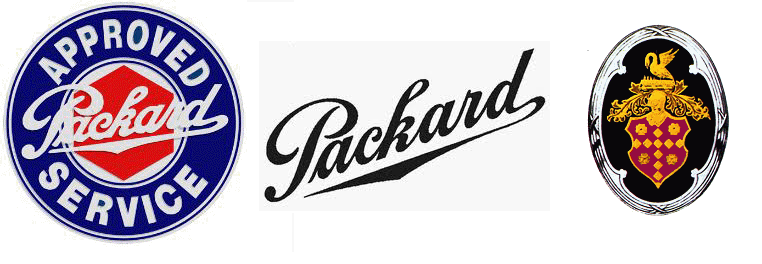Packard History

Packard was an American luxury automobile marque built by the Packard Motor Car Company of Detroit, Michigan, United States. The first Packard automobiles were produced in 1899, and the last Detroit-built Packard in 1956, when they built the Packard Predictor, their last concept car.
Packard bought Studebaker in 1953 and formed the Studebaker-Packard Corporation of South Bend, Indiana. The 1957 and 1958 Packards were actually badge engineered Studebakers, built in South Bend.
Packard was founded by James Ward Packard, his brother William and their partner, George Lewis Weiss, in the city of Warren, Ohio, where 400 Packard automobiles were built at their factory on Dana Street Northeast, from 1899 to 1903. A mechanical engineer, James Packard believed they could build a better horseless carriage than the Winton cars owned by Weiss, an important Winton stockholder, after Packard complained to Alexander Winton and offered suggestions for improvement, which were ignored. Packard's first car was built in Warren, Ohio, on November 6, 1899.[1]
Henry Bourne Joy, a member of one of Detroit's oldest and wealthiest families, bought a Packard. Impressed by its reliability, he visited the Packards and soon enlisted a group of investors—including Truman Handy Newberry and Russell A. Alger Jr. On October 2, 1902, this group refinanced and renamed the New York and Ohio Automobile Company as the Packard Motor Car Company, with James Packard as president. Alger later served as vice president.[2] Packard moved operations to Detroit soon after, and Joy became general manager (and later chairman of the board). An original Packard, reputedly the first manufactured, was donated by a grateful James Packard to his alma mater, Lehigh University, and is preserved there in the Packard Laboratory.[3] Another is on display at the Packard Museum in Warren, Ohio.[4]
In the beginning, all Packards had a single-cylinder engine until 1903.[1] Packard vehicles featured innovations, including the modern steering wheel and, years later, the first production 12-cylinder engine, adapted from developing the Liberty L-12, and air-conditioning in a passenger car. Packard produced its "Twin Six" model series of 12-cylinder cars from 1915 to 1923.[5]
As of October 1, 1954 Packard Motor Car Company bought the failing Studebaker Corporation to form the US's fourth largest automobile company but without full knowledge of their circumstances or consideration of the financial implications.[45] However, SPC's Nance refused to consider merging with AMC unless he could take the top command position (Mason and Nance were former competitors as heads of the Kelvinator and Hotpoint appliance companies, respectively), but Mason's grand vision of a Big Four American auto industry ended on October 8, 1954 with his sudden death from acute pancreatitis and pneumonia.
A week after the death of Mason, the new president of AMC, George W. Romney, announced "there are no mergers under way either directly or indirectly".[46] Nevertheless, Romney continued with Mason's commitment to buy components from SPC. Although Mason and Nance had previously agreed that SPC would purchase parts from AMC, it did not do so. Moreover, Packard's engines and transmissions were comparatively expensive, so AMC began development of its own V8 engine, and replaced the outsourced unit by mid-1956.[47] Although Nash and Hudson merged along with Studebaker and Packard joining, The four-way merger Mason had hoped for, which would have joined Nash, Hudson, Studebaker and Packard, did not materialize. The S-P marriage (really a Packard buyout) proved to be a crippling mistake. Although Packard was still in fair financial shape, Studebaker was not, struggling with high overhead and production costs and needing the impossible figure of 250,000 cars a year to break even. Due diligence was placed behind "merger fever", and the deal was rushed. It became clear after the merger that Studebaker's deteriorating financial situation put Packard's survival at risk.
In 1957, no more Packards were built in Detroit and the Clipper disappeared as a separate brand name. Instead, a Studebaker President–based car bearing the Packard Clipper nameplate appeared on the market, but sales were slow. Available in just two body styles, Town Sedan (four-door sedan) and Country Sedan (four-door station wagon), they were powered by Studebaker's 289 cu in (4.7 l) V8 with a McCulloch supercharger, delivering the same 275 hp (205 kW) as the 1956 Clipper Custom, although at higher revolutions. Borrowing design cues from the 1956 Clipper (visual in the grille and dash), with wheel covers, tail lamps, and dials from 1956 along with the Packard cormorant hood mascot and trunk chrome trim from 1955 senior Packards, the 1957 Packard Clipper was more than a badge-engineered Studebaker—but also far from a Patrician. Had the company been able to invest more money to finish the transformation and position the car under a senior line of "true Packards", it might have been a successful Clipper. However, standing alone the cars sold in very limited numbers—and a number of Packard dealers dropped their franchises while customers stayed away, despite huge price discounts, fearful of buying a car that could soon be an orphaned make. With the market flooded by inexpensive cars, minor automakers struggled to sell vehicles at loss leader prices to keep up with Ford and GM.[49] Also, a general decline in demand for large cars heralded an industry switch to compact cars such as the Studebaker Lark.
